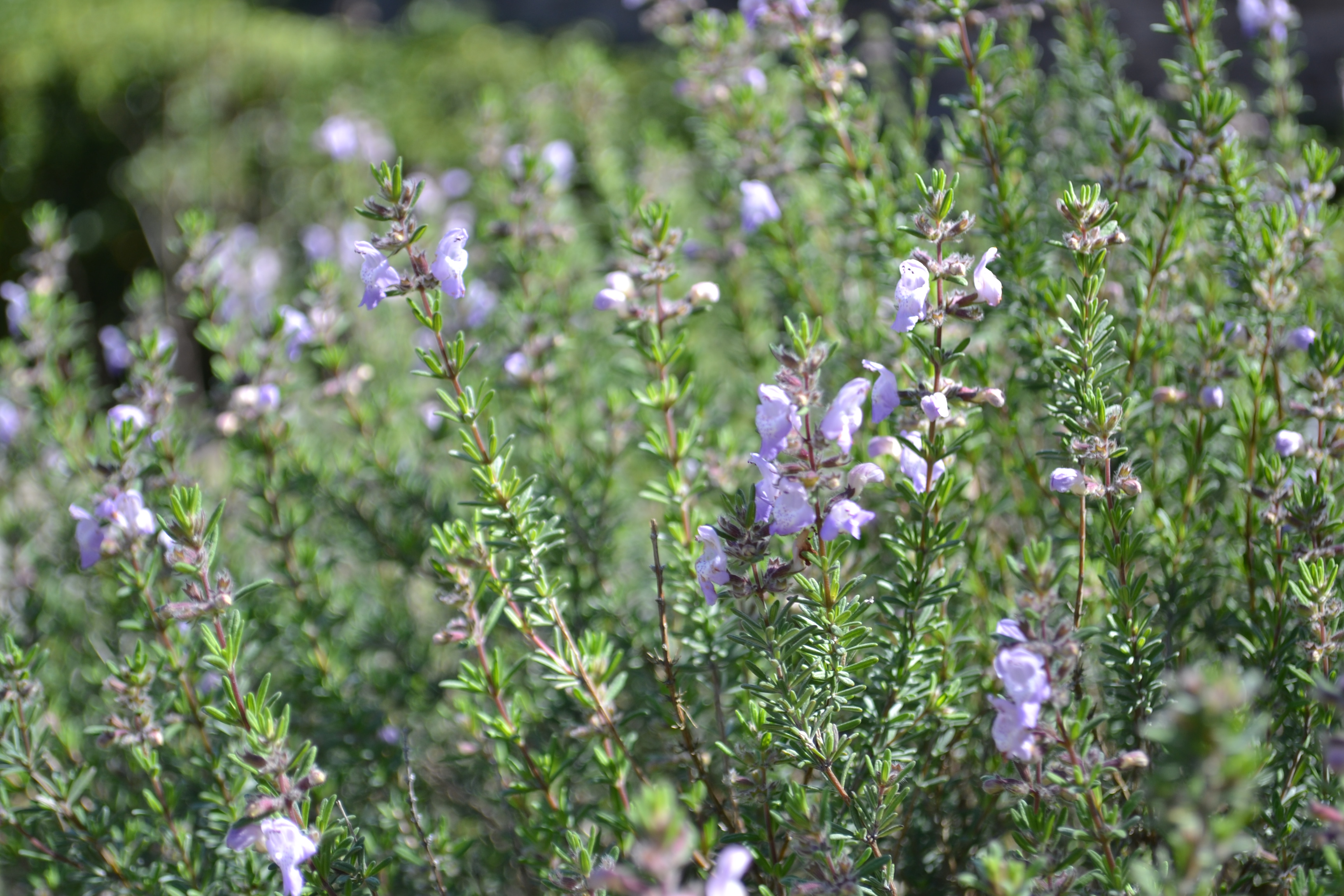
by Beth Bolles | Mar 30, 2017
We often talk about sandy, nutrient poor soil in Florida and how difficult it is for growing many favorite landscape plants. Gardeners may spend considerable time and money amending soils with organic matter to improve quality.
The low maintenance approach is to embrace your sandy soil and consider plants that thrive in sandy, well-drained soil. One very attractive native shrub that actually prefers this type of soil is false rosemary, Conrandina canescens.
False rosemary is a member of the mint family that is well adapted to drier, sandy soils. It can be found in many coastal communities growing in natural areas. It is easily recognized in the spring and early summer by light purple blooms. Considered a small shrub or groundcover, False rosemary needs full sun. One plant can easily spread out to 4-5 feet in diameter with a height of 2-3 feet.
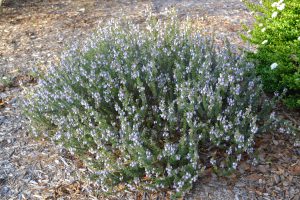
False rosemary is an attractive native plant for Gulf Coast landscapes. Photo by Beth Bolles, UF Escambia County Extension
False rosemary does have aromatic foliage and is attractive to bees. It is a very low maintenance plant once established and its few issues tend to be related to soils with too much moisture and plants being shaded after establishment. New seedlings will emerge around the main plant when growing conditions are right. If you want to try this native plant in your landscape, talk to a local nursery.
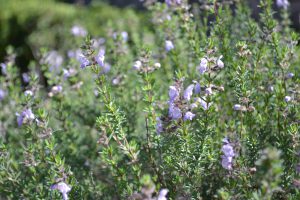
False rosemary flowers are attractive to pollinators. Photo by Beth Bolles, UF Escambia County Extension
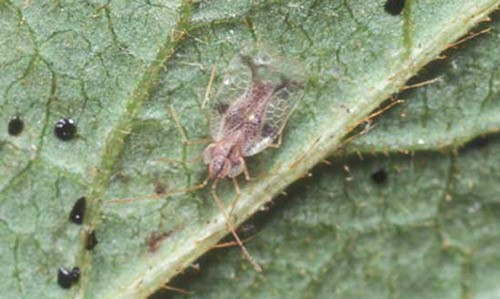
by Sheila Dunning | Mar 20, 2017
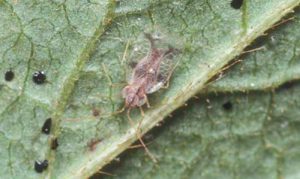 Now is the time to prevent your azaleas from being attacked by lace bugs. The azalea lace bug, Stephanitis pyrioides, overwinters as eggs on the underside of infested leaves. Eggs hatch in late March and early April. The insect then passes through five nymphal instars before becoming an adult. It takes approximately one month for the insect to complete development from egg to adult and there are at least four generations per year. Valuable plants that are susceptible to lace bug damage should be inspected in the early spring for the presence of overwintering lace bug adults, eggs and newly hatched nymphs. Inspect these plants every two weeks during the growing season for developing lace bug infestations.
Now is the time to prevent your azaleas from being attacked by lace bugs. The azalea lace bug, Stephanitis pyrioides, overwinters as eggs on the underside of infested leaves. Eggs hatch in late March and early April. The insect then passes through five nymphal instars before becoming an adult. It takes approximately one month for the insect to complete development from egg to adult and there are at least four generations per year. Valuable plants that are susceptible to lace bug damage should be inspected in the early spring for the presence of overwintering lace bug adults, eggs and newly hatched nymphs. Inspect these plants every two weeks during the growing season for developing lace bug infestations.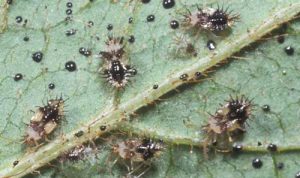
Both adults and nymphs have piercing-sucking mouthparts and remove sap as they feed from the underside of the leaf. Lace bug damage to the foliage detracts greatly from the plants’ beauty, reduces the plants’ ability to produce food, decreases plant vigor and causes the plant to be more susceptible to damage by other insects, diseases or unfavorable weather conditions. The azalea can become almost silver or bleached in appearance from the feeding lace bug damage.
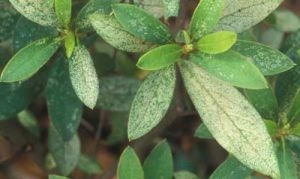 However, lace bugs often go undetected until the infested plants show severe damage sometime into the summer. By then several generations of lace bugs have been weakening the plant. Inspecting early in the spring and simply washing them off the underside of the leaves can help to avoid damage later and the need for pesticides.
However, lace bugs often go undetected until the infested plants show severe damage sometime into the summer. By then several generations of lace bugs have been weakening the plant. Inspecting early in the spring and simply washing them off the underside of the leaves can help to avoid damage later and the need for pesticides.
Adult lace bugs are flattened and rectangular in shape measuring 1/8 to 1/4 inch long. The area behind the head and the wing covers form a broadened, lace-like body covering. The wings are light amber to transparent in color. Lace bugs leave behind spiny black spots of frass (excrement).
Lace bug nymphs are flat and oval in shape with spines projecting from their bodies in all directions. A lace bug nymph goes through five growth stages (instars) before becoming an adult. At each stage the nymph sheds its skin (molts) and these old skins often remain attached to the lower surface of infested leaves.
Azalea lace bug eggs are football-shaped and are transparent to cream-colored. Lace bug eggs are found on the lower leaf surface, usually alongside or inserted into a leaf vein. Adult females secrete a varnish-like substance over the eggs that hardens into a scab-like protective covering.
For more information go to: http://entomology.ifas.ufl.edu/creatures/orn/shrubs/azalea_lace_bug.htm
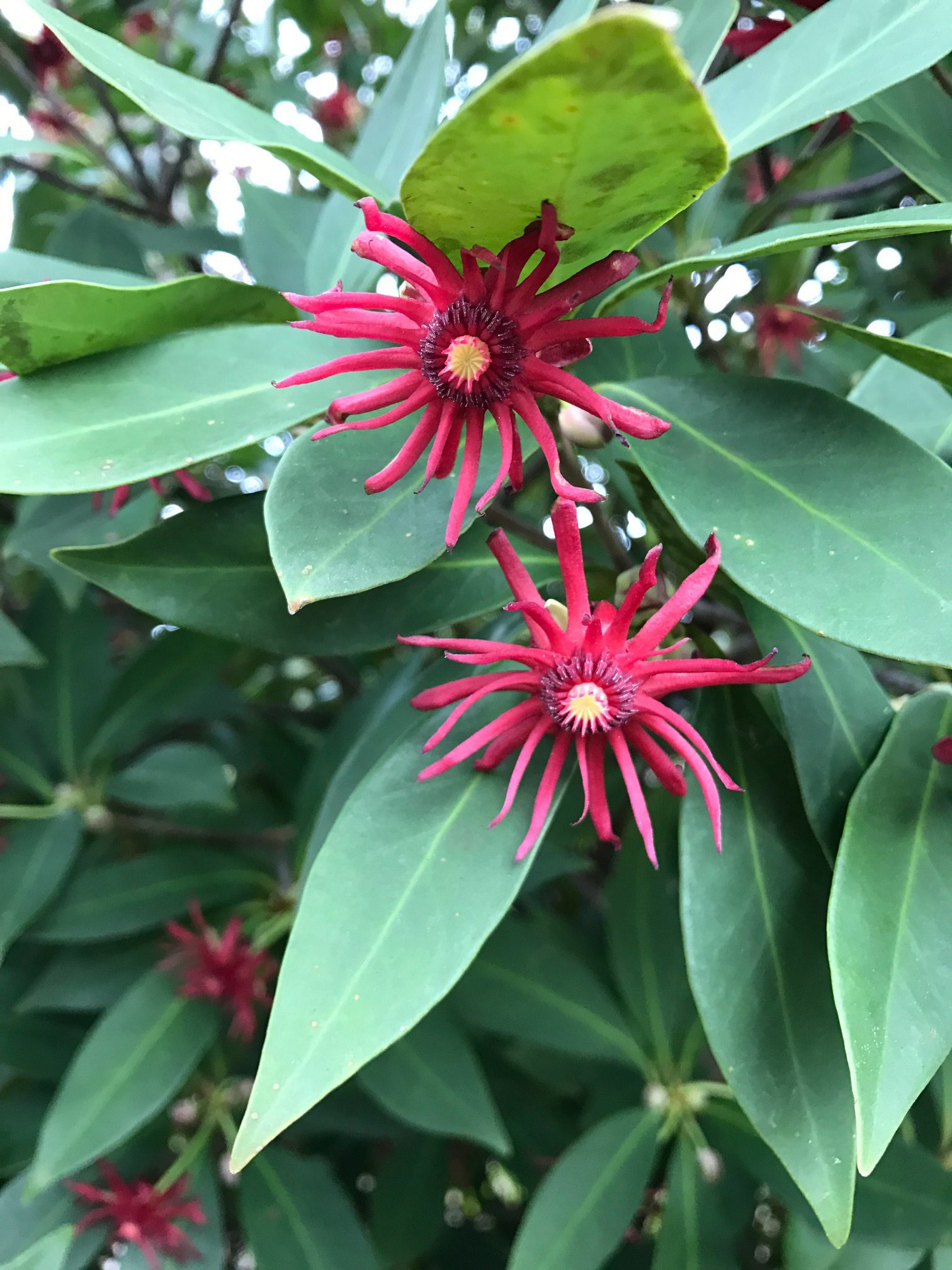
by Mary Salinas | Mar 9, 2017
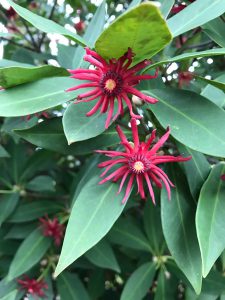
Dark red flowers of Florida red anise arrive in the springtime. Photo credit: Mary Derrick, UF/IFAS Extension.
Springtime brings small but very pretty red blooms on an outstanding native shrub/small tree, Florida red anise (Illicium floridanum). It occurs naturally in the wild in the central and western panhandle of Florida and west along the gulf coast into Louisiana. Its natural environment is in the understory along streams and in rich, wooded areas.
This is a great shrub for a part shade to shady and moist area in your landscape. The dense foliage, dark green leaves and the fact that it is evergreen all year makes it a great choice for an informal hedge. Plan for it to grow to a maximum height of 12 to 15 feet.
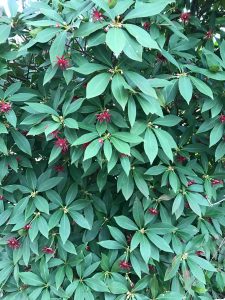
Dense growth habit of Florida red anise. Photo credit: Mary Derrick, UF/IFAS Extension.
The leaves have a licorice-like aroma when crushed but this is NOT the species that gives us the edible culinary anise. Maybe it is that aroma that makes this a relatively pest-free plant!
Yellow anise (Illicium parviflorum) is a very similar native shrub but has small yellow flowers and adapts better to a drier environment. The native range of the yellow anise is north central Florida.
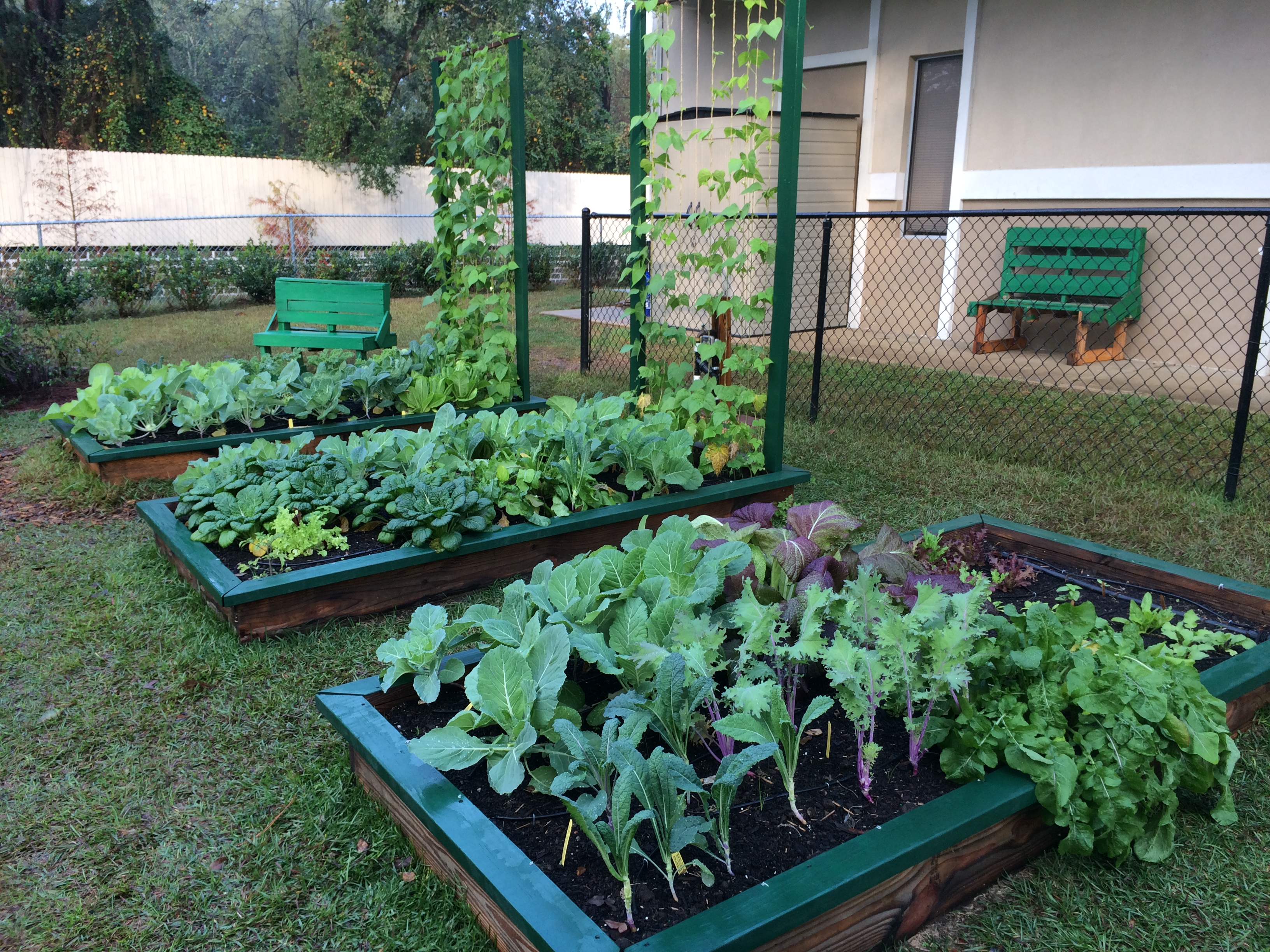
by Molly Jameson | Mar 1, 2017

Raised-bed gardening can maximize production in a small amount of space. Photo by Molly Jameson.
Want to start a vegetable garden, but don’t know where to start? Are you seeing rectangular boxes popping up all over your neighbors’ yards and wondering why? Well, I am here to spread the news of raised-bed gardening!
Raised-bed gardening is a convenient way to grow vegetables without worrying about the quality of your soil. This is because you will be bringing in a high quality soil mix to your site. Vegetable plants need nitrogen, phosphorus, potassium, and many other nutrients to grow and mature properly. In many Florida Panhandle soils, we either have too much sand, too much clay, and nearly always, not enough organic matter. Organic matter results from the various stages of decay of anything that was alive. Think of it as the “glue” that holds the soil together, improves both soil moisture-holding capacity and drainage, and slowly releases nutrients that become available to the plant.

Organic matter is the “glue” that will hold your soil together. Photo by John Edwards.
Although you could add nutrients and organic materials to your soil without building a raised bed, the walls of a raised bed will hold your soil in place, reduce erosion, and even help keep out weeds. Here are a few things to consider when planning the installation of a raised-bed garden:
Location
The most important thing to consider when picking your location is sunlight. Vegetable plants need a lot of direct sunlight for optimum production. Leafy vegetables (lettuce, kale, arugula) can tolerate four to five hours, but fruiting crops (tomatoes, squash, peppers) generally need six hours of full sunlight to grow strong and produce fruit.
When starting a garden, remember that we are in the northern hemisphere, and this means the sun dips to the south, especially in the winter. Objects therefore cast a shadow to the north, so pay attention to the position of southern tree lines, houses, and anything else that may block the sun. If you must choose, morning sun is better than afternoon sun, as afternoon sun can be very extreme in our area, especially in the summer.
Lastly, consider visibility! If you stick your garden in the very back corner of your yard, how often will you see it? The more visible it is in your daily life, the more likely you will notice easy-to-pull weeds, when your garden needs watering, what is ready to be harvested, and everything else that goes on in the garden.

Although wood is most popular, you can use materials such as concrete, bricks, or tiles to build a raised bed. Photo by Molly Jameson.
Materials
Now you have chosen a perfect garden location. What materials should you use to build your raised bed? Lumber is the most popular material. But you could use concrete blocks, bricks, tiles, or anything else that can support soil. You can make your beds as long as you like, but the important thing to remember is not to make the raised bed wider than four feet. This will allow you to reach all areas of your soil without stepping into the bed, which causes compaction. If you are working with kids, two or three feet wide is even better. You should make the height of your bed 10 to 12 inches, which will allow good drainage and enough space for your vegetable plants to develop strong roots.
When choosing lumber, you can go with untreated or treated wood. Within the last 15 years, wood preservatives considered unsuitable for raised-bed gardening have been phased out. There is well-documented research that has shown the newer products are considered safe for gardening. Although untreated wood typically will not last as long as treated, even treated wood will still begin to decompose after a few seasons. Either way, connect your wood with lag bolts, instead of nails, to hold the wood together tightly.

When filling a four ft. by eight ft. raised bed, you will need about 1 cubic yard of soil mix. Photo by Molly Jameson.
Soil
Now that you have your raised-bed structure built, what will you put in it? There are many landscape and nursery companies that can offer vegetable garden soil mixes for purchase in bulk. Typically, they will be about 50 percent compost (organic matter) and 50 percent top soil (nutrient-containing minerals). If you are filling a four foot by eight foot by 12 inch raised bed, you will need about one cubic yard of soil mix, which typically costs $30 to $60. This is about the volume of the back of a pick-up truck. If you do not have access to a truck, most companies will deliver in bulk for a $30 to $50 fee. This could be worth it if you are filling up multiple beds! Seasonally, you will then need to top off your raised bed as your soil will shrink as the organic materials decompose. But for this, you can buy bagged soil mixes or make your own compost.
The last step is filling your raised bed with vegetable plants! This could also be considered the first step… as you now must consider plant spacing, spring vs. fall vegetables, seeding into the garden vs. using transplants, trellising, pest control, harvesting…but we’ll save all that for future articles. Happy gardening!
by Julie McConnell | Feb 23, 2017
Regardless of what the tag says one size does not fit all. As with clothing, a piece will undoubtedly be too large for some and too small for others. Trying to go with a “one size fits all” approach to lawn care will lead to the same kind of frustration and disappointment as an ill-fitting garment.
All turfgrass is not created equal. Thus management of our various turf species requires different methods. It is common for a homeowner to be unaware of what type of turfgrass they have – it’s all grass after all – what difference does it make? Misidentification leads to problems because proper management for one type may be counterproductive to another type. In order to create a practical turf management plan, it is critical that the species of grass is properly identified.

Although many grasses look similar it is important to know exactly what kind you have to maintain it properly. This photo shows Empire Zoysia. Photo credit: Julie McConnell, UF/IFAS
Why is it important to know the species of turf in a lawn?
Two of the most common mistakes extension agents observe is excessively low mowing height of St. Augustinegrass and over-fertilizing Centipedegrass. Both of these errors can reduce turfgrass vigor and decrease its tolerance to pest issues. Another potential maintenance pitfall is using a herbicide that is not labeled for use on a given type of turfgrass. Several popular herbicides available on the market can cause damage to St. Augustinegrass and/or Centipedegrass. Thus turf can be inadvertently killed by herbicides when they are applied to the wrong species.
Before a lawn maintenance plan is developed, be sure to know what type of grass is present and then follow UF/IFAS recommendations for proper care. If assistance is needed with identification, contact your local extension office.
To learn more about lawn care, visit this site or plan to attend “Caring for Your Florida Lawn” at the UF/IFAS Extension Bay County office on April 8th. For more details call 850-784-6105.

by Carrie Stevenson | Feb 23, 2017

Azaleas have been in full bloom this year since mid-February. Photo credit: Carrie Stevenson
It’s mid-February, and regardless of the groundhog’s prediction, spring seems to have arrived in northwest Florida. In my neighborhood, all the azaleas have bloomed. While beautiful, it’s something that usually doesn’t happen around here until well into March!
According to NOAA and NASA climate data, 2016 was the hottest year globally on record, followed by the previous hottest years, 2015 and 2014. In fact, 16 of the 17 warmest years documented (since official record keeping began in 1880) have been since 2001. The United States also experienced a record-setting year of natural disasters in 2016, ranging from floods to droughts and wildfires.
As the warming trend continues, gardeners, farmers, and wildlife managers alike will find it necessary to adjust their long-held practices. When plants bloom or put on fruit early, these changes can have real economic and commercial impacts. Farmers compete on a global scale to get products to market, and if northern climates start experiencing warmer temperatures, Florida farmers could lose their competitive edge.

Juvenile bats are vulnerable and therefore protected by state laws during late spring through summer in Florida. Photo credit: Carrie Stevenson
In natural systems, a change in migration or hatching could affect the success of a protected species’ survival. The time frames for these life stages are often legally protected by state or federal laws. For example, in Florida, bats cannot be “excluded” from a building between the April 16-August 14 due to the maternity season. Beach re-nourishment projects are restricted and heavily monitored during sea turtle nesting from May-October. If these time frames start skewing earlier in the year due to changing temperatures and early onset of spring and summer, laws or common practices might need to be evaluated and changed.
In response to these changes in weather patterns, the interesting science of phenology (not to be confused with the brain-mapping “science” of phrenology) has regained popularity in recent years. Phenology is the study of when annual events in the natural world begin—the first hatching of shorebirds, the blooming of spring flowers, the migration of butterflies. For many years, both amateur and professional naturalists have kept records of these phenomena, observing them for pure scientific interest. Now, phenology research has become real-time documentation of a changing world. There are several national networks of citizen scientists making observations and recording them online, including Project Budburst, FrogWatch USA, and the National Phenology Network. If you enjoy spending time outdoors, consider joining one of the many phenology networks and contributing to the larger body of scientific observation. The more we understand about climate-related changes, the better we can prepare and adapt.


















